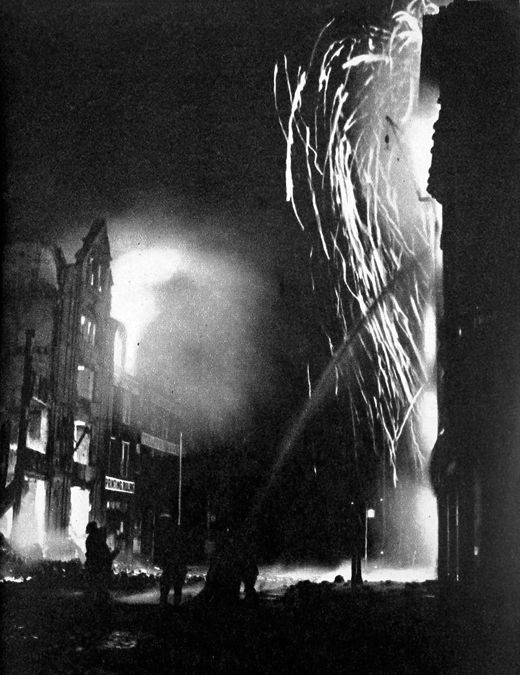The Blitz
Fire Fighting in Southwark |
 |
There is a massive night raid on London by about 300 bombers which last about 8 and one half hours. Each bomber makes 2 or 3 sorties for a total of 685. 6 bombers are lost. They drop over 1,000 tons of bombs and mines. The targets are the docks, warehouses and factories along the Thames. Destruction is widespread. 60 public buildings are hit including the Admirlaty, the Law Courts and the Houses of Parliament. St Paul's Cathedral is also damaged in the bombing. Large shops in Leicester Square and Oxford Street are destroyed. 19 churches are destroyed or damaged along with 18 hospitals. 66 of the city's boroughs are hit covering most of the capital. 2,250 fires burn, mainly in central and south London. 50 of the fires are of the serious category. 1,180 people are killed and 2,230 are injured. This is a reprisal raid for the RAF raid on Berlin April 9.
[Battle of the Atlantic
- In a German air attack the British steamers Angelesea Rose (1151t) and Amiens (1548t) and the Norwegian steamer Bolette (1167t) north of St Ives. The crews of both British ships are rescued, 8 are lost from the Norwegian ship.
- The Norwegian steamer Favorit (2826t) is sunk by German bombing southwest of the Faroes. The entire crew is rescued.
Diplomatic Relations
Talks begin in Washington between U.S. and Japanese officials. Roosevelt opens outlining 4 essential points as a foundation for relations between nations: 1) territorial integrity; 2) noninterference in the affairs of other countries; 3) equal commercial opportunity; and 4) a status quo in the Pacific.
[German Raiders
The Swedish steamer Sir Ernest Cassell (7739t) is sunk by the German raider Thor in the middle of the Atlantic. The entire crew are taken as prisoners of war.
[Greece
Wavell gives orders, on the basis of the situation both in North Africa and Greece, that the sailing of the 7th Australian Div and the Polish Bde from Egypt is to be cancelled. This is effectively a decision to abandon the Greek campaign and indeed Papagos is already suggesting that the British leave Greece in order to minimize the damage to his country.
German panzers from Macedonia reach the Pindus Mountain passes and cut off the escape routes of Greek troops in Albania. German 2nd Army units begin attacking Allied positions at the Servia Pass, with the plain of Thessaly lying open beyond it.
[Mediterranean
- At 2:20p.m. an important German convoy of 5 transports escorted by 3 Italian destroyers en route to Libya with supplies for Axis forces in North Africa is attacked by 4 British destroyers near Kerkinnah Island off Cape Bon, Tunisia. All the ships in the convoy (totaling 14,000t) and 3 of the escorting destroyers (the Tarico, Lampo and Baleno) are sunk. The steamers lost are the German Andana (4205t), Aegina (2447t), Arta (2452t) and Iserlohn (3704t) along with the Italian Sabaudia (1590t). The British lose 1 ship, the destroyer Mohawk with the loss of 41 of her crew. 161 survivors are rescued by the British destroyer Nubian. About 1,250 of the 3,000 German troops are rescued by the Italian destroyers Vivaldi and Da Noli.
- The Greek steamer Memas (4359t) is sunk by German bombing at Chalkis.
North Africa
The 15th Pzr Div is deployed for the first time in North Africa as Rommel prepares to launch another assault on Tobruk.
[Yugoslavia
The Germans occupy Sarajevo. The Italians take Antivari and Danilovgrad, while a landing party of the San Marco Regt seizes the island of Krk.
Ante Pavelic is sworn in to head the new Croat republic. Over the next few months his Ustase followers, Roman Catholic Croats, will murder about 500,000 people, most of them Orthodox Serbs, who will be presented with a choice between re-baptism and death. Many Jews are also killed. Unusually the local Catholic priests will be involved in the massacres. Elsewhere in Occupied Europe the Catholic clergy will have a fine record in resistance work.
[